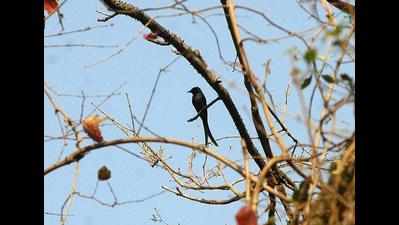- News
- City News
- rajkot News
- Khijadiya no more a bird paradise
Trending
This story is from December 10, 2016
Khijadiya no more a bird paradise

Khjiadiya (Jamnagar): By this time of the year, Khijadiya Bird sanctuary, 10 km from Jamnagar, is a site to behold. Thousands of flamingoes, pelicans and cranes flock, making this sprawling wetland a paradise for bird watchers.
But this year, the scene is opposite. While migratory birds are barely visible, bird lovers have to be content seeing only those that are present throughout the year.
Reason: Rampant construction inside the sanctuary in the name of beautification and chopping of bushes and shrubs that were natural nesting sites has resulted in the sanctuary virtually turning into a picnic spot.
Several bunds separating bodies of sweet and salt water have been extended for a long distance, which has brought people at a disturbing distance from the heronry. Khijadiya wetland is made of numerous small and big water bodies that are separated by elevated bunds. Hundreds of cement benches have been constructed on the fringes of the wetland so that picnic goers can have a “closer look” at the birds. Moreover, diesel pumps have broken the serenity of the place to draw fresh water from the wetland to water large number of bottle palms and coconut trees planted along the pathways.
Asad Rahmani, former director of Bombay Natural History Society (BNHS), has actually called for criminal action against those responsible for these actions.
“Those responsible for destructing of this wetland should be booked and punished under the Wildlife Protection Act as destruction of habitat is also a crime under the Act,’’ Rahmani told TOI.
In fact, black-necked stork, painted stork, black-headed ibis and Oriental darter, which are categorized as ‘near threatened’ breed here.
“Khijadiya was one of the finest bird sanctuaries in the country. It provides unique assemblage of fresh and saline wetlands. But its habitat is fast degrading by such unwelcome activities’’ Rahmani added.
Jaypalsinh Jadeja, a technical committee member for ‘Birds of Khijadiya’ a coffee table book published by the government, said, “There is a massive habitat destruction underway and the change is scaring away the birds. Installing a ‘Burmese swing’ which connects pathway (bund) to birds’ roosting and nesting sites in the middle of wetland is beyond common sense. New access points have been built at places that were earlier banned for people as they disturbed the birds.
Shyamal Tikadar, chief conservator of forests, Marine National Park, however, asserted that they are only following a proper management plan to improve the habitat. “Only some portion of the sanctuary is used for recreational purpose. We should also keep in mind what people want. This is a public property we reserve something for their happiness,’’ Tikadar said.
Referring to removal of vegetation, the officer said that they were removing gando baval that has spread on large swathes of land. “We are making changes in the wetland to retaining water as last three years have been rain-deficient,” he said.
But this year, the scene is opposite. While migratory birds are barely visible, bird lovers have to be content seeing only those that are present throughout the year.
Reason: Rampant construction inside the sanctuary in the name of beautification and chopping of bushes and shrubs that were natural nesting sites has resulted in the sanctuary virtually turning into a picnic spot.
Several bunds separating bodies of sweet and salt water have been extended for a long distance, which has brought people at a disturbing distance from the heronry. Khijadiya wetland is made of numerous small and big water bodies that are separated by elevated bunds. Hundreds of cement benches have been constructed on the fringes of the wetland so that picnic goers can have a “closer look” at the birds. Moreover, diesel pumps have broken the serenity of the place to draw fresh water from the wetland to water large number of bottle palms and coconut trees planted along the pathways.
Ornithologists and wildlife experts are aghast at such construction within the sanctuary.
Asad Rahmani, former director of Bombay Natural History Society (BNHS), has actually called for criminal action against those responsible for these actions.
“Those responsible for destructing of this wetland should be booked and punished under the Wildlife Protection Act as destruction of habitat is also a crime under the Act,’’ Rahmani told TOI.
In fact, black-necked stork, painted stork, black-headed ibis and Oriental darter, which are categorized as ‘near threatened’ breed here.
“Khijadiya was one of the finest bird sanctuaries in the country. It provides unique assemblage of fresh and saline wetlands. But its habitat is fast degrading by such unwelcome activities’’ Rahmani added.
Jaypalsinh Jadeja, a technical committee member for ‘Birds of Khijadiya’ a coffee table book published by the government, said, “There is a massive habitat destruction underway and the change is scaring away the birds. Installing a ‘Burmese swing’ which connects pathway (bund) to birds’ roosting and nesting sites in the middle of wetland is beyond common sense. New access points have been built at places that were earlier banned for people as they disturbed the birds.
Shyamal Tikadar, chief conservator of forests, Marine National Park, however, asserted that they are only following a proper management plan to improve the habitat. “Only some portion of the sanctuary is used for recreational purpose. We should also keep in mind what people want. This is a public property we reserve something for their happiness,’’ Tikadar said.
Referring to removal of vegetation, the officer said that they were removing gando baval that has spread on large swathes of land. “We are making changes in the wetland to retaining water as last three years have been rain-deficient,” he said.
End of Article
FOLLOW US ON SOCIAL MEDIA











